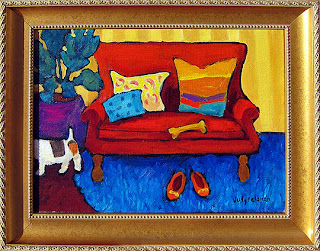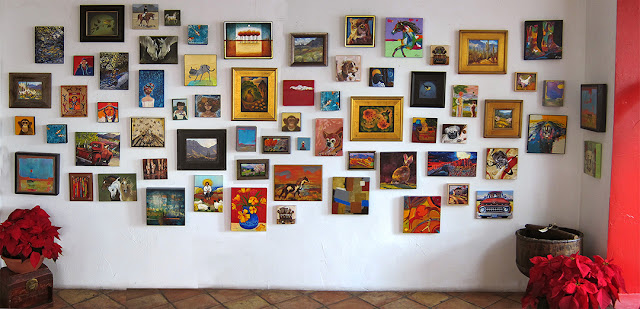It’s time again for Wilde Meyer’s annual Gem Show, the show of smaller paintings by many of the gallery’s artists. For most of us, this is a change from our regular formats, and small paintings present their own challenges.
When I started thinking about my own paintings, large and small, and looking at some of the other participating artists, I began to consider that we tend to keep our same style and subject matter, but we have to make some changes to succeed in this smaller context.
 | |
| Time for a Walk 11.5"x14.5" oil on canvas by Judy Feldman |
I love to paint interiors. I just finished one called “Interior with Red Chair.” But I couldn’t just shrink it! In my Gem Show painting, entitled “Time for a Walk.” I think I conveyed feeling of an inviting place, but with fewer elements. And, of course, the dog got smaller (by walking off the canvas!) With “A Christmas Surprise,” I purposely created a small image, focusing mainly on the new puppy in the box.
 |
| Bandit 4"x4" acrylic on canvas by Ryan Hale |
Ryan likes to interpret patterns of aerial views of landscapes. He’s fascinated by how land is divided, especially when seen from above, where civilization and nature both co-exist and collide. You can appreciate his intentions in these larger paintings entitled “Daily Intervals,” which measures 60”X72”, and “The Forming Earth,” which is 36”X36.”
So, when it came time to do some 12”X12” paintings, Ryan decided to work on several at once, so they would be related and could be hung together in different orientations. While he was painting them, he would move them around. “It’s a challenge, like creating a puzzle,” he said. “I takes a lot of thought to get a strong enough image on a small canvas.”
 |
| Structure IV 12"x12" acrylic on canvas by Ryan Hale |
 |
| Structure III 12"x12" acrylic on canvas by Ryan Hale |
 |
| Along the High Road oil on canvas 26"x41.75" by Leigh Gusterson |
 |
| Taos Mountain Sunset 6.25"x9.25" by Leigh Gusterson |
 |
| Glorious Tree in Pilar 5.25"x9.25" by Leigh Gusterson |
 |
| Gem Show 2012 |
You might be a bit overwhelmed when you see the wall of small paintings at the Gem Show. But it’s worth taking the time to look carefully, and ask Laura, Ryan or Jonathan to show the ones you like by themselves. It’s challenging to paint small, but the result is really a “gem!”
 |
| Gem Show 2012 |



















